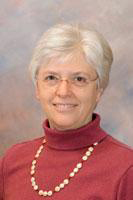KU center lands $1.75M grant to aid test accessibility for students with disabilities
LAWRENCE – The power of technology continues to alter the landscape of K-12 student testing, but without careful planning some students might have less access to its benefits than others.
A new, two-year, $1.75 million federal grant awarded to the Center for Educational Testing and Evaluation, in cooperation with the Kansas Department of Education, will determine how to make computer-delivered, technology-enhanced tests more accessible to students with vision and motor disabilities, a group for whom it has been difficult to ensure test access and parity with other students.
When implemented during the 2014-2105 school year, the tests, currently being developed by five multistate assessment consortia, will represent a major shift in the application of technology and educational testing innovation in K-12 schools across the country.
"The key feature of the standardized assessments being developed nationwide for both general education and special education students will be their use of desktop, laptop and touch-screen tablet technology for test delivery. Blindness, low-vision and motor disabilities interfere tremendously with sitting at a computer and taking a test," said Julia Shaftel, research associate at the center and principal investigator on the two-year Accessibility of Technology-Enhanced Assessments project, funded by the U.S. Department of Education.
"These disabilities are some of the hardest to accommodate on a computerized assessment," said Neal Kingston, director of the Center for Educational Testing and Evaluation. "So, the major purpose of the ATEA project will be to identify how to validly and accurately include students with vision and/or motor disabilities in all assessments that are under development by the five consortia."
The Kansas Department of Education will provide coordination and operational support, while the center will conduct the research and create a catalog of accessible test questions and accessibility guidelines for test developers. State departments of education in Utah, Wisconsin, West Virginia, Michigan and Missouri will also participate by providing advice and access to students.
Additionally, researchers will catalog information about how students with vision and motor disabilities take tests and the accommodations and accessibility tools that they use.
"What are the characteristics of students with blindness? What percentage uses a keyboard to take tests? Do students who use Braille perform similarly to sighted students? Who are the students with motor disabilities? What percentage uses a keyboard, a modified keyboard or switches to communicate? What percentage uses an eye-gaze or sip-and-puff system to record their answers?" Shaftel asked.
By working with 3,600 students in six states and administering specially prepared tests to students with and without vision and motor disabilities, the project will have enough data to make valid statistical comparisons. When differences due to inadequately accessible technology are found, alternative ways for students to interact with the questions will be sought.
The idea is to attain score comparability.
"Every time you test a student and you give them a score, say a student receives a 90 percent, you're making assumptions about what that means. You're assuming that the score means the same thing as a 90 percent score for every other student taking the test, that we're testing the same academic constructs and getting the same information about that student's knowledge. For students with vision and motor disabilities, we've just assumed that their scores from the accommodated test are comparable to the scores of students who don't take the test with those accommodations, and that they reflect the same level of knowledge and skill, but it's never been studied whether those assumptions are accurate," Shaftel said.
Under investigation will be accessibility of the technology-enhanced test questions and accompanying tasks, planned technology-enabled accessibility features, and anticipated accommodations for students with vision and/or motor disabilities. These might include text-to-speech screen readers, refreshable Braille displays, adaptive keyboards, raised grid graph paper and other tactile tools, screen enlargement and assistive technologies such as eye-gaze, switch or sip-and-puff systems.
The Center for Educational Testing and Evaluation is a nationally recognized research center specializing in large-scale assessment and online test delivery systems. For more than 30 years, the center has developed cutting-edge testing programs and technology tools. Through its partnership with the Kansas Department of Education, the center offers assessments to all 289 Kansas school districts. During the 2011-2012 school year, it administered 4.6 million test sessions online, and 99.8 percent of the Kansas general and modified assessments were administered by computer using the center's testing software.
